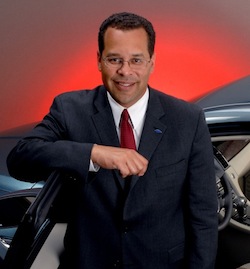Ford adds water to foremost sustainability concerns

Automaker Ford's corporate sustainability strategy has two big focuses: to reduce the impact of the vehicles it manufactures and, in turn, to reduce the footprint of the operations that make those products. On both counts, the company reported continued progress in its annual sustainability report issued today.

During a conference call to discuss the report, one of the company's chief sustainability executives said Ford is adopting a more aggressive stance when it comes managing the fresh water it uses. "We have really elevated water as a significant issue," said John Viera, Ford's global director for sustainability and vehicle environment matters, during the briefing.
The goal during 2011 is to reduce water usage by 5 percent per vehicle compared with 2010 metrics, Viera said. Over the past decade, he noted that Ford has already dramatically decreased its consumption -- by up to 49 percent per vehicle. "We really want to focus not just on water reductions but what impact we are having as we grow our operations throughout the world," he said.
There are four major levers that Ford uses to guide its sustainability strategy decisions: what its competitors are doing (short term, mid term and long term), what consumers want, what the government is requiring, and what science says is possible.
Using that mindset, here are some of the automaker's latest success stories and renewed sustainability pledges:
- Carbon dioxide emissions for the 2010 model year have been reduced by 10.5 percent for U.S. products and 8.1 percent for European vehicles, when compared with the 2006 model year
- From an operational standpoint, Ford managed a 5.6 percent reduction in carbon dioxide emissions between 2010 and 2009.
- Ford has set a new goal for facility's related carbon dioxide emissions: A reduction of 30 percent by 2025 on a per-vehicle basis.
Perhaps most significant, Viera said that Ford delivers 12 vehicles that have best-in-class fuel economy for their model family; four Ford models get better than 40 miles per gallon in terms of fuel efficiency. "That is a claim that no other full-line manufacturer can match," Viera said.
Ford's electrification strategy continues to advance. Just last week, the company said it would triple production capacity for electrified vehicles in North America by 2013. It already has delivered its first all-electric vehicle, the Transit Connect Electric. The Focus Electric will become a factor by the end of the year in 19 U.S. pilot markets; Viera said the target consumer is an individual that can travel within an 80- to 100-mile range before charging. In the pipeline are the C-MAX Hybrid and the C-MAX Energi plug-in hybrid, which are due in 2012 in the United States and one year later in Europe.
Viera said Ford will continue to embrace a posture of diversification when it comes to the alternative fuel technologies that its vehicles use. That means you shouldn't discount the impact of hybrids or of models that use either ethanol or compressed natural gas, according to Viera. "There is no silver bullet," he said. Later on in the call, he noted: "We need access to all energy types."
During the question and answer portion of the conference, some intriguing issues were raised that should also be on our radar with respect to Ford's future sustainability initiatives. The include:
- Heightened attention to the conflict minerals sourcing issues. Viera said Ford is looking to some of its electronics and technology partners as well as the State Department for more information, and you can expect Ford to articulate its strategy more clearly in the next 12 months.
- How to recycle even more of a vehicle at the end of its life. Apparently, right now, roughly 85 percent of vehicles today (by weight) are recyclable. The hardest things to recycle are the electronics (although that is changing), adhesives and glass. Ford is continuing its research on approaches to all of these areas, Viera said.
This post was originally published on Smartplanet.com